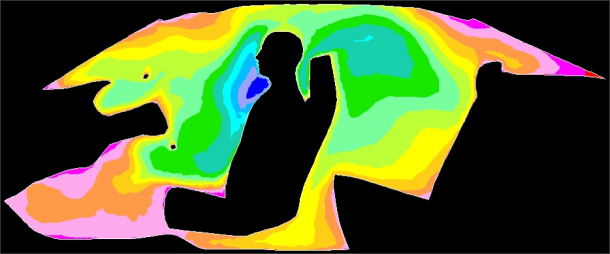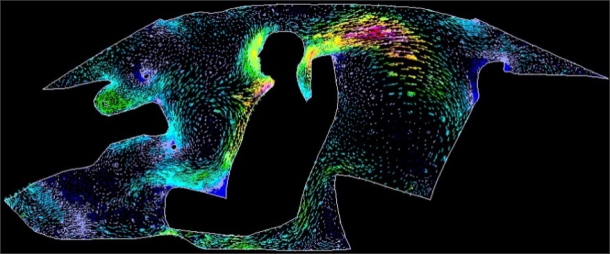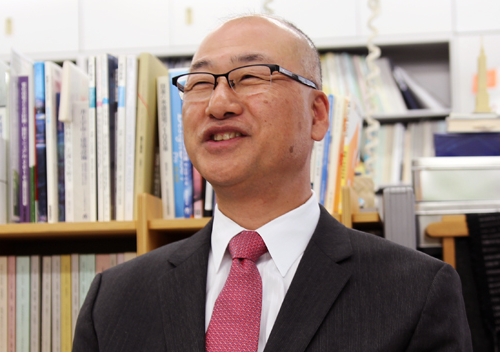Waseda Frontline Research Vol. 10 – 1: Saving Energy at Your Convenience (Part 1 of 2)
Mon, Apr 18, 2016-
Tags
Professor Shin-ichi Tanabe from the Faculty of Science and Engineering
Forty years of pursuing comfort

Energy conservation topics, such as the energy mix of the Basic Energy Plan, CO2, and other reduction targets under the COP21 Paris Agreement, have become increasingly widespread in our society, especially since the 2011 Great East Japan Earthquake. We spoke twice with Professor Shin-ichi Tanabe, who is an expert on energy efficiency in buildings and saving energy comfortably.
Managing temperature and brightness in architectural spaces
My area of expertise is architectural environment engineering, the pursuit of a perfect balance between the building’s environmental performance and comfort. Rather than a subjective input, I visualize environmental factors, such as temperature, humidity, and brightness, of homes, offices, and other buildings, by using indisputable numerical data and propose measures for improvement.
Unlike most people who are interested in architectural design, I majored in architecture to examine how people could manipulate their environment and live comfortably on low-energy consumption. It was during my master’s studies that I became fully aware of the necessity of taking comfort into account. I took part in a project to build a passive solar house which vigorously absorbed light and heat from the sun. After its completion, we measured the indoor thermal environment and were astonished by the gap between the results and our forecast calculations. However, this was no mystery since we had disregarded human activity and only considered heat transfers from windows and walls and the amount of energy in watt-hours required for air-conditioning. Through this experiment, we realized that the indoor thermal environment completely changed through daily activities, such as opening windows for ventilation even in winter and closing curtains when the house was vacant during the day. Including human parameters in our building environment research became essential.
The pursuit of comfort
When I was looking for a way to calculate comfort during my doctoral studies, I had the opportunity to study under P.O. Fanger, a leading figure in the field, at the Technical University of Denmark. I was also fortunate to become acquainted with fellow researchers who are now all over the world. They have become excellent rivals as well as mentors for me since then. Because of this experience, I encourage doctoral students in my laboratory to study abroad as early on as possible. The friends we make in our twenties will be cherished for a lifetime.
After I completed my PhD, I was offered a position at Ochanomizu University’s Department of Textile and Clothing at the Faculty of Home Economics and stepped away from architecture. There, I utilize the comfort evaluation methods I had studied by assessing the wear comfort of clothes using thermal mannequins, life-sized dummies that maintain their surface temperature resembling a human being. I also worked on evaluating thermal comfort in vehicles. There is little awareness of heating in gasoline cars since they exhaust heat, but heating electric cars increases energy consumption and dramatically reduces the vehicle’s driving range. Not installing any heating would impair comfort; hence, we studied what could be done and eventually discovered a way to deliver heat to drivers and passengers by directly warming car seats.

Figure 1(a): Results of numerical fluid analysis of in-car thermal environment (thermal field)

Figure 1(b): Results of numerical fluid analysis of in-car thermal environment (wind speed field)
In the 1990s, talks about sick building syndrome, which causes health problems and discomfort, started to emerge. We received a budget from the Science and Technology Agency (currently the Ministry of Education, Culture, Sports, Science and Technology) to create a device for measuring chemicals released from building materials. The chemical density in a room varies depending on ventilation volume, temperature, and humidity. We needed to know the exact amount of chemicals released to take required countermeasures. We were not in the best of circumstances given our limited budget and small laboratory space, but we built a small chamber with a twenty-liter capacity. Now known as the Waseda method, this chamber has been standardized among the Japanese Industrial Standards.

Figure 2: A small chamber called an ADPAC, which measures the release rate of chemicals from building materials. Used for ministry certification testing
Later, I was offered a position at Waseda University where I currently work. Since coming here, I have shifted the focus of my research to conserving energy comfortably. What comes to mind for most people when asked about energy conservation is the restricted use of energy. It has been my belief since university that we can live comfortably and healthily while reducing energy consumption.
For energy conservation but against 28 degrees
The “Cool Biz” campaign launched in 2005 originally entailed setting all air conditioners to 28 degrees, but in recent years, the term has come to imply smart-energy conservation in which cooling devices are set to reasonable temperatures. I was engaged in research to provide scientific support for Cool Biz, but my conclusion exasperated those who were involved at the time. Although I agreed with dressing lightly to save energy, I disagreed with setting the temperature uniformly to 28 degrees.
A suitable temperature for offices is generally 26 degrees, but even this is higher than offices in parts of Europe, North America, and Asia. I believe the real way to implement Cool Biz is to achieve energy efficiency by maintaining comfort while easing this temperature limit. For example, one proposed method is to improve comfort by installing a radiation cooler at each desk, making it possible to control air conditioning on an individual level. The results of demonstration experiments showed that this method was effective, and it will be introduced in some skyscrapers in Otemachi, Tokyo.
Waseda’s unique research system
We are able to continue our research on actual buildings through the support of and understanding of Waseda University alumni working in the architecture and construction industry. For my students, being involved in real projects to construct residential or commercial buildings is equivalent to conducting a case study at business school. The students participate by offering new ideas to plans brought in by alumni. Moreover, installation systems and energy consumption of post-construction indoor environment are usually not measured, but in cooperation with our alumni, students can numerically assess comfort in addition to work efficiency and suggest improvements, a PDCA cycle which also becomes part of research. In particular, buildings are a unique product, and no two construction structures have the same design or performance. We will never obtain desired results by only installing energy efficient facilities unless we inspect each building and create specific favorable indoor environment.
☞Click here for volume 2

Figure 3: Faculty, alumni and students form teams and take part in projects
Profile
 Professor Shin-ichi Tanabe
Professor Shin-ichi Tanabe
Professor Tanabe graduated from Waseda University’s Department of Architecture, School of Science and Engineering in 1982 and then from the Graduate School of Science and Engineering in 1984. He holds a PhD in engineering. He was a researcher at the Laboratory of Heating and Air Conditioning at the Technical University of Denmark from 1984 to 1986 and named assistant professor at the School of Science and Engineering at Waseda University in 1986. He served as a full-time lecturer at Ochanomizu University’s Faculty of Home Economics from 1988 and became an associate professor at the Faculty of Human Life and Environmental Sciences from 1992. He was also a visiting scholar at the University of California, Berkeley from 1992 to 1993. He returned to Waseda as an associate professor in the Department of Architecture, School of Science and Engineering, from 1999 and later as professor in the same department. He was appointed professor in the Department of Architecture, School of Creative Science and Engineering, Faculty of Science and Engineering, Waseda University in 2007 after reorganization. His current non-academic positions include Chair of the Japanese Association of Building Mechanical and Electrical Engineers, Vice President of the Architectural Institute of Japan, Chair of the Environmental Council and Tokyo Metropolitan Government among others.
Achievements
Research
- S. Tanabe, M. Haneda and N. Nishihara, “Workplace productivity and individual thermal satisfaction”, Building and Environment, 91, 42-50 (2015).
- N. Nishihara, P. Wargocki and S. Tanabe, “Cerebral blood flow, fatigue, mental effort, and task performance in offices with two different pollution loads”, Building and Environment, 71, 153-164 (2014).
- R.J. De Dear, T. Akimoto, E.A. Arens, G. Brager, C. Candido, K.W.D. Cheong, B. Li, N. Nishihara, S.C. Sekhar, S. Tanabe, J. Toftum, H. Zhang and Y. Zhu, “Progress in thermal comfort research over the last twenty years”, Indoor Air, 23(6), 442-461 (2013).
- S. Tanabe, Y. Iwahashi, S. Tsushima and N. Nishihara, “Thermal comfort and productivity in offices under mandatory electricity savings after the Great East Japan earthquake”, Architectural Science Review, 56(1), 4-13 (2013).
- Y. Kobayashi and S. Tanabe, “Development of JOS-2 human thermoregulation model with detailed vascular system”, Building and Environment, 66, 1-10 (2013).
Publications (available in Japanese only)














